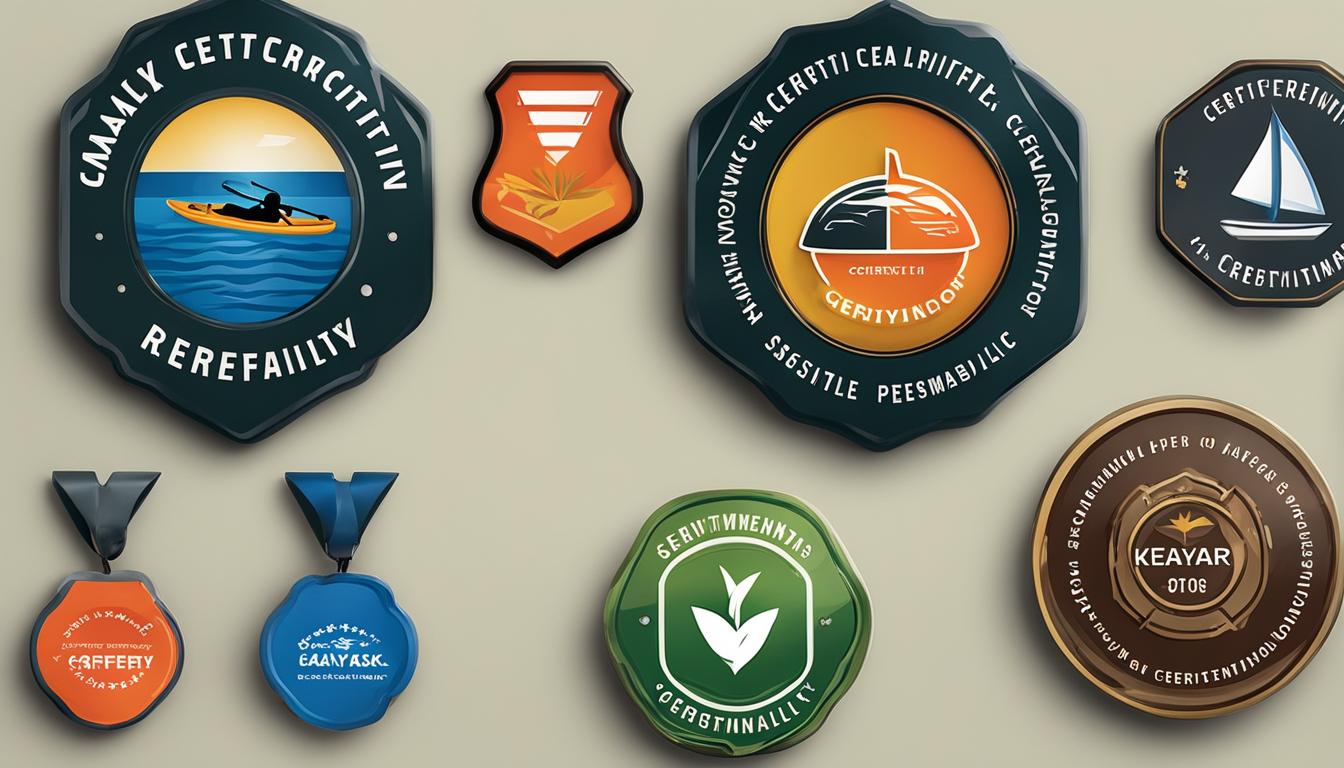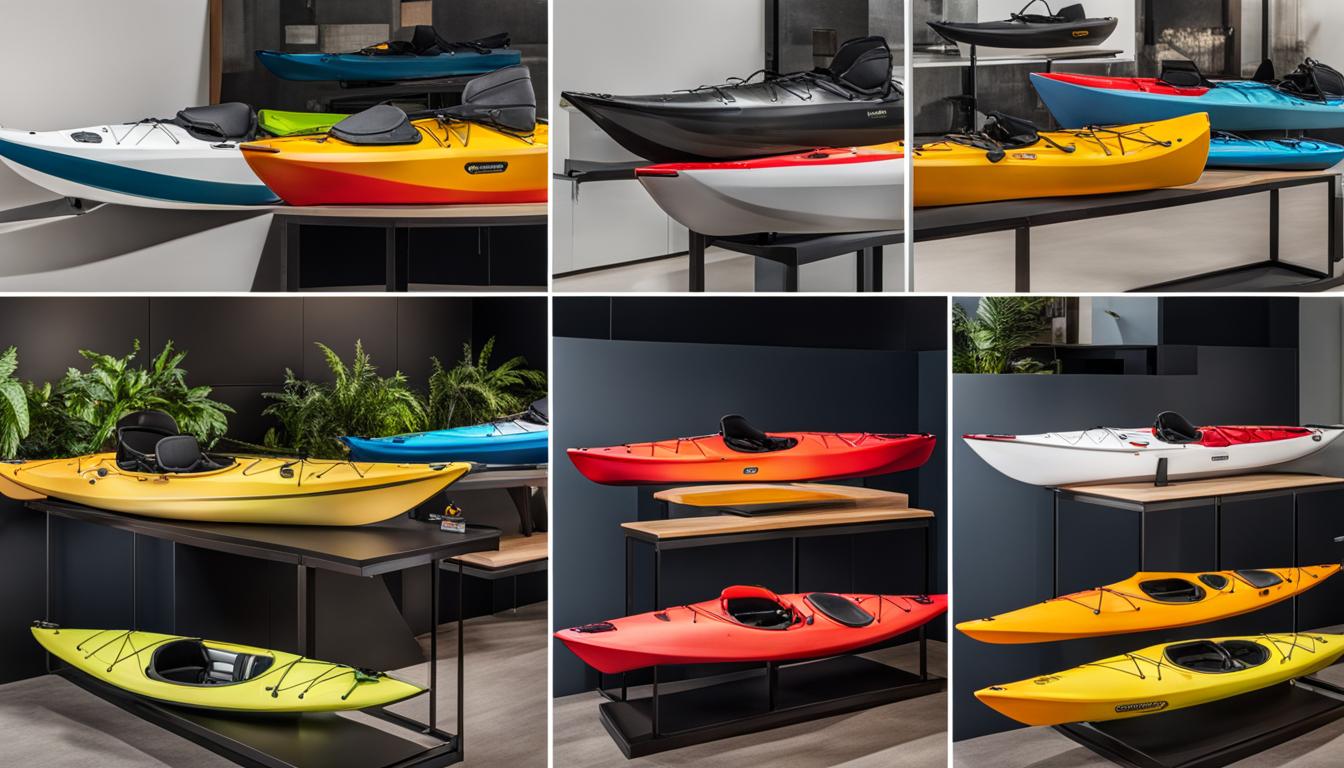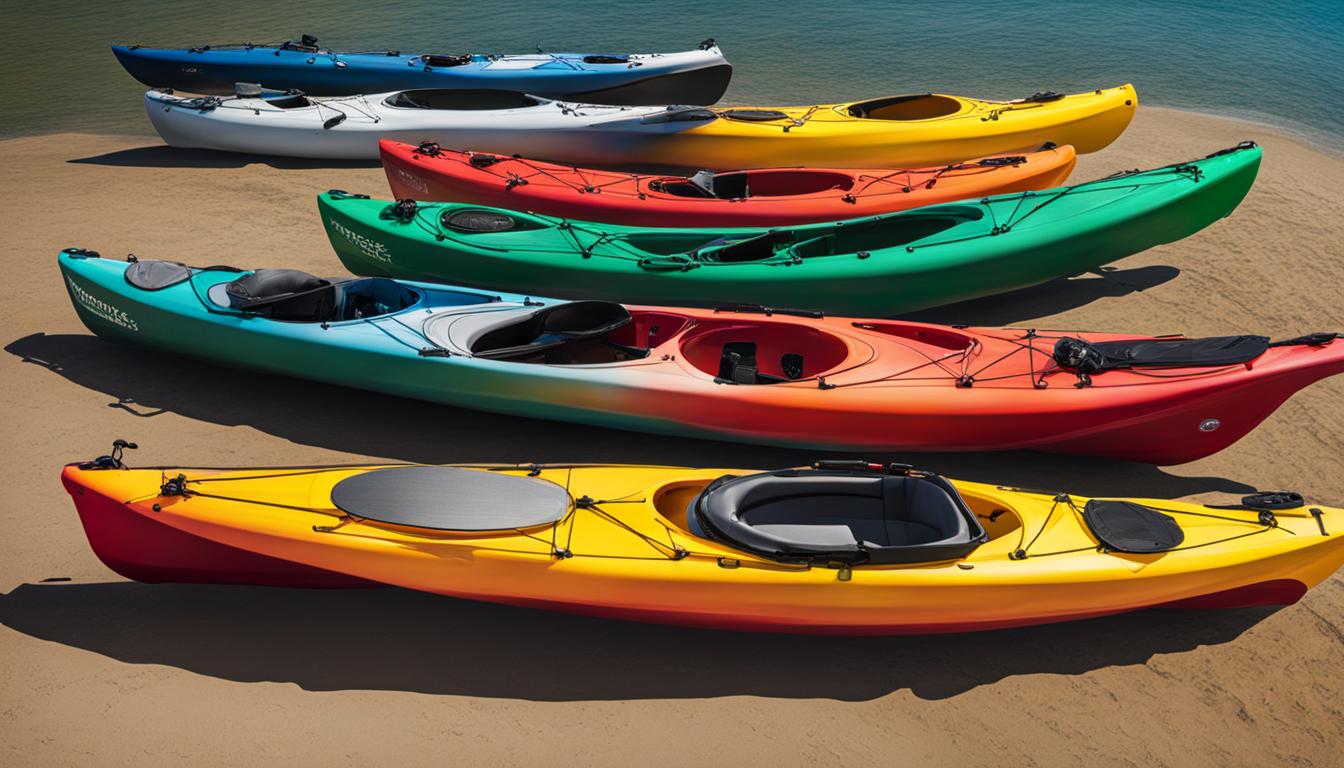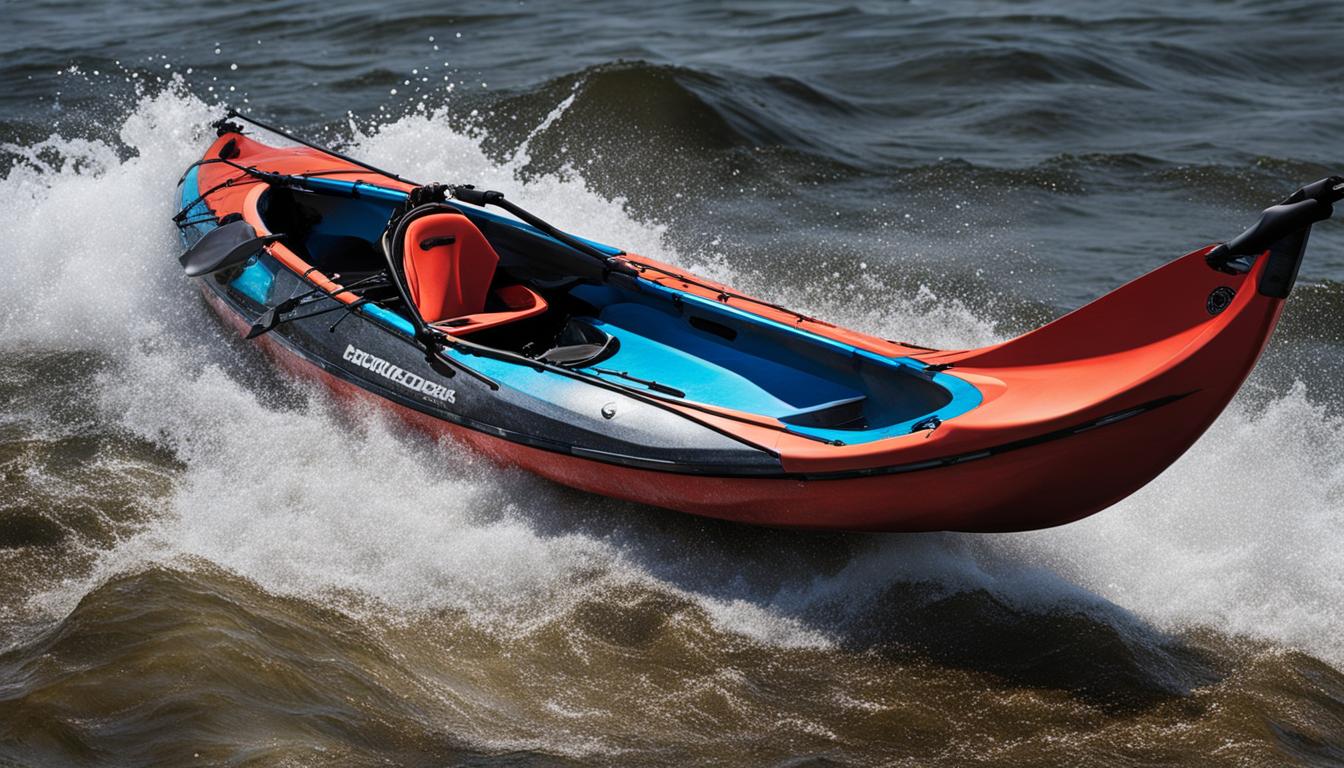When purchasing a kayak, it’s important to consider the certifications that ensure the quality and safety of the boat. One certification to look for is the NMMA certification, awarded by the National Marine Manufacturers Association. This certification indicates that the kayak meets the manufacturing standards set by the American Boat & Yacht Council. Another important certification is the NMMA Boat & Yacht Certification, which goes beyond the minimum regulations required by the US Coast Guard. It’s also worth considering certifications related to the materials used in the kayak’s construction, such as the use of eco-friendly and sustainable materials. By choosing a kayak with these certifications, you can have peace of mind knowing that you’re purchasing a high-quality and safe product.
Key Takeaways:
- Consider certifications such as the NMMA certification to ensure quality and safety of the kayak.
- Look for the NMMA Boat & Yacht Certification for boats that go beyond minimum regulations.
- Pay attention to certifications related to materials used in the kayak’s construction.
- Choosing a certified kayak ensures you’re purchasing a high-quality and safe product.
- Keep in mind the importance of eco-friendly and sustainable materials in kayak manufacturing.
The Benefits of Inflatable/Packable Kayaks
Inflatable or packable kayaks offer a range of advantages that make them a popular choice among paddlers. Their increased portability is one of the main benefits. These kayaks can be folded or rolled into a compact size, making them easy to transport and store. Whether you’re hiking to a remote waterway or simply have limited storage space at home, inflatable kayaks offer convenience and flexibility.
Not only are these kayaks portable, but they also come with certifications that ensure their safety and compliance with industry standards. For example, the NMMA certification guarantees that the kayak meets recognized safety requirements. This provides peace of mind to paddlers knowing that their kayak is built with certified designs and materials.
Inflatable kayaks are also known for their durability. Many models are designed to withstand challenging conditions, including whitewater rapids. Reinforced seams and rugged materials make inflatable kayaks tough and resilient, even in harsh environments. Additionally, many inflatable kayaks are made from eco-friendly materials, earning certifications that promote environmental sustainability.
Key Benefits:
- Increased portability
- Compliance with safety certifications
- Durable construction
- Eco-friendly materials
Overall, choosing an inflatable or packable kayak with the right certifications can offer convenience, safety, and environmental benefits. Whether you’re an adventurous paddler or a casual enthusiast, these versatile kayaks provide a great option for exploring the waterways.
| Certification | Description |
|---|---|
| NMMA Certification | Guarantees compliance with industry safety standards |
| Environmental Certification | Indicates the use of eco-friendly materials and sustainable manufacturing processes |
| Design Certification | Certifies that the kayak has been designed with safety and performance in mind |
| Industry Certification | Ensures compliance with specific kayak industry standards and regulations |
With the right certifications and features, inflatable and packable kayaks provide a convenient and reliable option for all types of paddlers. Whether you’re exploring calm lakes or tackling whitewater rapids, these kayaks offer the versatility and peace of mind you need for an enjoyable paddling experience.
Choosing the Right Kayak for Your Needs
Selecting the right kayak depends on various factors, including your paddling style, the type of water you’ll be kayaking in, and your desired level of comfort. If you’re a beginner, it’s recommended to start with an inexpensive and stable kayak to get a feel for the sport. Consider the environment in which you’ll be kayaking, as different kayaks are designed for specific water conditions. For example, whitewater kayaks are built to withstand rough rapids, while touring kayaks offer increased tracking for longer excursions.
When choosing a kayak, also pay attention to the certifications related to materials and manufacturing, as these ensure the quality and safety of the boat. Look for certified kayak materials and kayak manufacturing certifications, which guarantee that the kayak is made with high-quality materials and meets industry standards. These certifications can provide reassurance that the kayak is built to withstand the elements and will last for years to come.
In addition to certifications, it’s important to consider your comfort while kayaking. Look for kayaks with adjustable seating options and ample legroom to ensure a comfortable paddling experience. Some kayaks also offer additional features such as storage compartments or built-in fishing rod holders, which can enhance your time on the water. By considering all these factors, you can find a kayak that meets your needs, provides a safe and enjoyable experience, and allows you to fully immerse yourself in the beauty of nature.
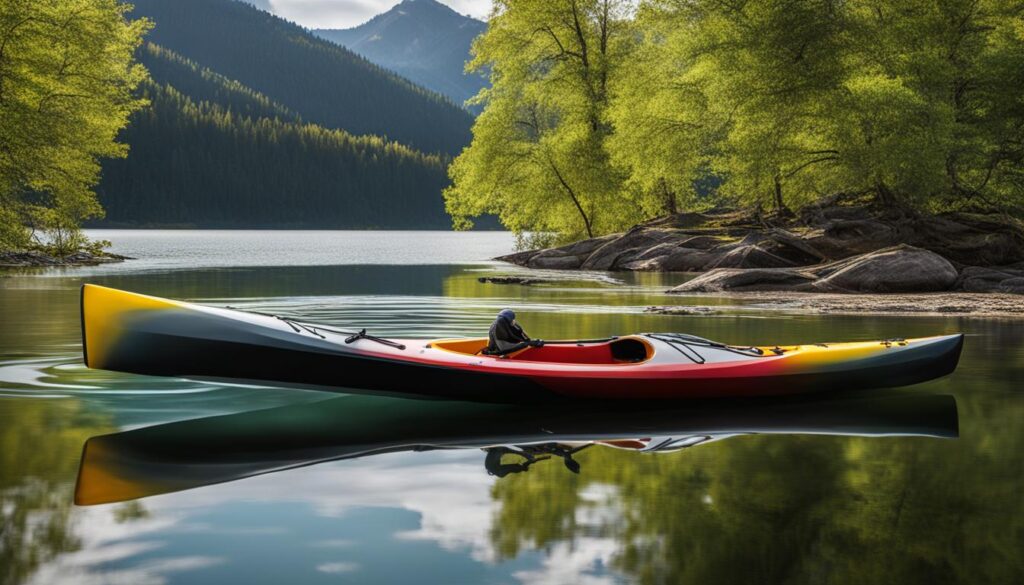
Table: Kayak Types and Recommended Environments
| Kayak Type | Recommended Environment |
|---|---|
| Recreational Kayak | Lakes, calm rivers, and protected coastal areas |
| Touring Kayak | Lakes, coastal areas, and open water |
| Whitewater Kayak | Rivers and rapids |
| Fishing Kayak | Lakes, rivers, and coastal areas |
Choosing the right kayak is a personal decision that depends on your specific needs and preferences. Take the time to research and test different kayaks to find the one that feels comfortable and suits your desired activities. Whether you’re a beginner or an experienced paddler, finding the right kayak will enhance your overall kayaking experience and allow you to explore the wonders of the water with confidence.
Considerations for Kayak Sizing
Proper sizing is crucial when buying a kayak to ensure comfort and safety while paddling. The size of a kayak refers to its volume, length, width, and weight. Manufacturers provide suggested weight ranges for each kayak model, so it’s important to choose one that falls within your weight range.
Additionally, sit in the kayak and check for proper fit. Make sure you can reach the foot supports, that your legs have comfortable contact with the thigh braces, and that the backrest provides proper support. It’s also important to consider the number of people the kayak can accommodate, especially if you plan to paddle with a partner.
Table: Kayak Sizing Recommendations
| Kayak Size | Weight Range | Capacity |
|---|---|---|
| Small | Less than 150 lbs | 1 person |
| Medium | 150-200 lbs | 1 person |
| Large | 200-250 lbs | 1-2 people |
| Extra Large | Above 250 lbs | 2-3 people |
Taking these sizing considerations into account will help you find a kayak that provides a comfortable and safe paddling experience.
Exploring Kayak Accessories
When it comes to enhancing your kayaking experience, there are a wide variety of accessories available that can cater to your specific needs and preferences. Whether you’re looking to add functionality, convenience, or comfort to your kayak, the right accessories can make a world of difference. Here are some popular kayak accessories to consider:
Bungee Deck Rigging:
Including bungee deck rigging on your kayak can provide secure storage for your gear. These elastic cords are typically attached to the deck of the kayak, allowing you to quickly and easily secure items such as dry bags, water bottles, or extra clothing.
Hatches and Storage Compartments:
Having additional storage space on your kayak can be invaluable, especially for longer trips or overnight adventures. Hatches and storage compartments can provide a watertight and secure place to store your belongings, keeping them safe and dry while you paddle.
Adjustable Backrests:
Comfort is key when spending extended periods of time on the water. An adjustable backrest can help provide proper support and alleviate any discomfort or strain on your lower back. Look for a backrest with multiple adjustment options to find the perfect position for you.
Fishing Rod Holders:
If you enjoy fishing from your kayak, a fishing rod holder is a must-have accessory. These holders securely hold your fishing rod, allowing for hands-free fishing while you paddle or relax on the water. Some rod holders even have adjustable angles and positions for added convenience.
Remember, when choosing accessories for your kayak, it’s important to ensure compatibility with your specific kayak model. Some kayaks are designed with certain accessories in mind, so be sure to research and select accessories that are suitable for your kayak. Additionally, consider your individual preferences and needs to customize and upgrade your kayak over time, creating the perfect setup for your paddling adventures.

Including the right kayak accessories can greatly enhance your paddling experience. Whether you’re looking to add storage options, increase comfort, or optimize your kayak for fishing, there is a wide range of accessories available to meet your needs. By investing in certified kayak designs and industry-approved accessories, you can ensure that your kayak setup is both functional and safe. Take the time to research and select the accessories that will best suit your preferences and enhance your time on the water. Happy paddling!
Conclusion
Purchasing a kayak is an exciting endeavor, and considering the various certifications can help guide your decision. Look for kayak safety certifications such as the NMMA certification, which ensures compliance with industry standards and guarantees the quality and safety of the kayak you choose.
When it comes to certified kayak brands, you can have peace of mind knowing that these brands have met stringent kayak quality standards. These certifications not only ensure the durability and performance of the kayak but also assure you that you are investing in a reliable and long-lasting product.
Furthermore, certified kayak designs are specifically engineered to enhance your kayaking experience. Whether you’re paddling in calm waters or challenging whitewater conditions, choosing a kayak with certified designs can provide you with the stability, maneuverability, and comfort you need.
By taking the time to research and consider the various certifications, you can make an informed decision and find the perfect kayak that meets your safety requirements and delivers an exceptional paddling experience.
FAQ
What certifications should I look for when buying a kayak?
It’s important to consider certifications such as the NMMA certification, which ensures compliance with industry standards. Additionally, certifications related to the materials used in the kayak’s construction can be worth considering.
What are the benefits of inflatable/packable kayaks?
Inflatable or packable kayaks offer increased portability and can be easily transported and stored. They often come with certifications such as the NMMA certification, ensuring their safety and compliance with industry standards. These kayaks are also known for their durability and are often made from eco-friendly materials.
How do I choose the right kayak for my needs?
Consider factors such as your paddling style, the type of water you’ll be kayaking in, and your desired level of comfort. It’s also important to pay attention to certifications related to materials and manufacturing to ensure the quality and safety of the kayak.
What should I consider when it comes to kayak sizing?
Proper sizing is crucial for comfort and safety while paddling. Consider the suggested weight ranges provided by manufacturers and ensure a proper fit by checking foot supports, thigh braces, and backrest support. Also, consider the number of people the kayak can accommodate, especially if you plan to paddle with a partner.
What accessories are available for kayaks?
There is a wide range of accessories available for kayaks, such as bungee deck rigging, hatches or storage compartments, adjustable backrests, and fishing rod holders. It’s important to choose accessories that are compatible with your kayak and suit your specific needs and preferences.

